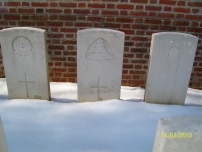| First Name: | William Charles | Last Name: | ASHTON | |
|---|---|---|---|---|
| Date of Death: | 01/07/1916 | Lived/Born In: | Dalston | |
| Rank: | Bombardier | Unit: | Royal Garrison Artillery 18th Trench Mortar Battery | |
| Memorial Site: | ||||
Current Information:Age-18 166 Richmond Road, Dalston Carnoy Military Cemetery, France In 1914 the British army had no trench mortars but as the war progressed and became bogged down in the stalemate of trench warfare, the need for such a weapon, became more and more apparent. Fired from the front line they were able to deal with individual targets such as machine gun nests or sniper posts and thereby assisting the infantry going into the attack. But they were not always welcome. Many an infantryman would complain bitterly about trench mortar sections that would join them in the front line trenches, fire a salvo of mortars and then disappear back, leaving the occupants to face the inevitable enemy retaliation. Many different models were tried until in mid 1915 the 3 inch Stokes mortar became standard issue and each division had three Medium Batteries attached, which had the same number as the division. There were also Light Mortars attached to Brigades and bearing the Brigade’s number.. When an attack went in it was the job of the men of the Trench Mortar Batteries to accompany the infantry forward and resume their fire from captured positions. It was dangerous work. The opening day of the Battle of the Somme 1st July 1916 This was a disastrous day for the British Army in France. Eleven divisions of Fourth Army attacked along a 15 mile front from Maricourt to Serre. Two further divisions of Third Army launched a diversionary attack just to the north of Serre at Gommecourt. For a week beforehand the British artillery pounded the German trenches but the Germans had been there for a long time and they had constructed deep, concrete reinforced shelters beneath their trenches and many survived the bombardment. The troops went over the top at 7.30am but even before they had left their overcrowded trenches, many had been killed or maimed by German artillery. The Germans knew that they were coming. Once in No-Man’s-Land the artillery continued to take its toll and then the machine guns opened up on the advancing British infantry. They fell in their thousands and the attack came to a standstill almost everywhere. Survivors sought cover wherever they could find it and at night they crawled back to their own lines, often dragging a wounded soldier with them. Only in the south were any advances made with the attack on Fricourt and Mametz. Over 19,000 British soldiers were killed on this day, including 2,500 from London. On 1st July, 1916, 18th Division, to which 18th Trench Mortar Battery was attached, was involved in one of the very few successful attacks when along with 30th Division they captured the village of Montauban on the right of the line of attack. |
||||
Other Photos: |
||||
| « Back to Search Results | ||||
| If you think any of the information shown here is incorrect, Click Here to submit your amends and comments | ||||





